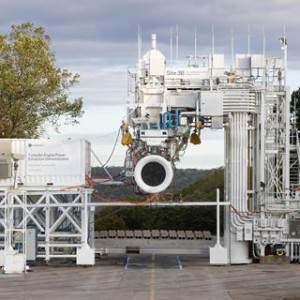GE begins testing Passport-based hybrid-electric propulsion system

GE Aerospace recently started test running the Passport-turbofan-based hybrid-electric propulsion system it developed under NASA's Hybrid Thermally Efficient Core (HyTEC) programme, one of several company efforts to advance technologies for future narrowbody aircraft engines. "We are in the real thick of it right now," GE hybrid-electric systems leader Christine Andrews says of the run tests, which started several weeks ago. "It's going as well as it possibly could go... It's already proven a successful test."
The company is conducting the tests at its facility in Peebles, Ohio and expects the runs will continue through year-end.
 GE has several hybrid-electric projects underway through which it aims to develop technologies sufficiently mature for 2030s service entry. It has said the work will inform the design of the open-rotor engine affiliate CFM International is developing under the Revolutionary Innovation for Sustainable Engines (RISE) programme.
GE has several hybrid-electric projects underway through which it aims to develop technologies sufficiently mature for 2030s service entry. It has said the work will inform the design of the open-rotor engine affiliate CFM International is developing under the Revolutionary Innovation for Sustainable Engines (RISE) programme.
GE insists the open rotor, likely with hybrid features, will power the next generation of narrowbody jets. GE's HyTEC prototype consists of a Passport turbofan (the engine powering some Bombardier Global business jets) mated to "motor/generators". The system can operate with or without batteries, which is notable because the state of battery technology, specifically the need for higher-storage batteries, is a factor viewed as possibly limiting the practicality of some hybrid-electric architectures for aviation.
"This could help accelerate the introduction of hybrid-electric technologies for commercial aviation prior to energy storage solutions being fully matured," the company has said. For the run tests, GE hooked its hybrid system to "test-enabling hardware, to handle loads and move power where we want it, when we want it," says Andrews. It is evaluating the system's performance under various configurations, such as with the hybrid system extracting power from the engine and with it inserting power - to varying degrees of each and at different simulated phases of flight (take-off, climb, descent, cruise, landing).
"The configuration... would be different across the flight envelope," Andrews says. "The point of the test is to explore... the most-efficient [configuration] as we look toward our next-generation" propulsion system. Under the HyTEC programme, NASA tasked industry to develop smaller engine cores that, by burning hotter and at higher temperatures, are 5-10% more efficient than today's turbofan cores. The cores are to contain a degree of hybridisation, and the system must extract 10-15% of the cores' power as electricity - four times more than possible with today's engines.
Competitors Pratt & Whitney and Honeywell also won NASA HyTEC development contracts. GE has been busy with related programmes. It is developing and maturing a megawatt-class hybrid propulsion system using a GE CT7 turboprop and a modified Saab 340B turboprop under NASA's Electric Powertrain Flight Demonstration programme.
GE has aimed for that aircraft to make first flight by the middle of this decade.
Also, in 2022 GE finished testing a "high-voltage" hybrid propulsion system (composed of electric motor-generators, power converters and power control systems) at simulated altitudes of 45,000ft.